The Seventh Battle of Ruusan was the final major engagement of the conflict known as the New Sith Wars. There were actually seven prior battles on the world during the last days of the war, but the pivotal and last battle was the one most remembered, due to the use of the thought bomb; it was usually referred to as just the Battle of Ruusan. It was also the event that would lead to the Ruusan Reformation of the Galactic Republic.

Jedi and Sith battling on Ruusan
The New Sith Wars began 2,000 years before the Battle of Yavin and ended after a thousand years of conflict, including internal Sith conflict, and all-out assaults on the Galactic Republic. At one stage during the long war, the Sith had been in control of most of the galaxy, but the Army of Light slowly regained the Republic's lost territory with decades of hard-fought campaigns.
Eventually, the Sith retreated to Ruusan, where, after two years of battle with the Jedi in six separate battles, the Sith were near defeat.
The Jedi Lord Valenthyne Farfalla crushed the Sith in the pivotal seventh battle of Ruusan. Sith Lord Darth Bane, who desired to destroy the Brotherhood of Darkness and reform the Sith, aided the Jedi by ordering the Sith's Fleet to break formation and engage the Jedi, which allowed the Jedi to gain the upper hand and force the Sith to retreat. Neither side, however, were aware of Bane's true motives. Sith Lord Skere Kaan and his forces retreated to the caves, where Kaan planned to use the thought bomb that Bane had provided him, to destroy the Jedi. Kaan, however, was being deceived by Bane, as the Thought Bomb would really destroy every Force-sensitive being caught in its radius. After Farfalla and his forces reached the Caves, the Sith guarding the caves surrendered, while Sith Lord Kopecz informed him of Kaan's plan before being killed in a duel with Farfalla. Upon Hoth and his forces arrival, Farfalla informed him of Kaan's plan. Hoth and 99 other Jedi went inside the Cave to apprehend Kaan and the Brotherhood, despite knowing that they were sure to meet their deaths.
In an act of desperation, Kaan, leader of the Sith, unleashed the thought bomb and in an instant, every Force-sensitive in the blast radius was destroyed. Lord Farfalla had retreated with the majority of the Army of Light in accordance with Lord Hoth's final orders. The only surviving Sith was Bane, who, while leaving the battlefield, came across the young girl Zannah, whom he would take on his apprentice under his new rule.

Darth Bane, survivor of the Sith
The conclusion of the final confrontation on Ruusan led to the apparent extinction of the Sith, and the restructuring of the Republic and of the Jedi Order.
Afterwards, the Jedi Johun Othone built a monument at the battlefield to commemorate the fallen Jedi of the war. It became known as the Valley of the Jedi, and was a powerful Force nexus. For over a thousand years the spirits of Hoth, of Kaan, and of countless other Jedi and Sith would remain trapped in the Valley, until they would be freed by mercenary-turned-Jedi Kyle Katarn in 5 ABY.
The Jedi were unaware that Bane had survived and continued the Sith, under his new rule, Rule of Two. Due to the Sith's assumed destruction, the Sith managed to operate in secret, beginning with Bane and Zannah. The Sith hid within the Republic until their existence was finally revealed with the rise of Emperor Palpatine, whose apprentices included Darth Maul, Darth Tyranus, and finally Darth Vader.
The return of Anakin Skywalker, once Darth Vader, to the light, and the demise of the Emperor, who was the last true master of Darth Bane's reformed Sith Order, brought to fruition the prophecy of the Chosen One who would bring "balance to the Force".
In the fifth part of the blog series Star Wars: The Essential Guide to Warfare Author's Cut, when covering the cut section of a different take on the Battle of Ruusan, author Paul R. Urquhart stated that the battle's real life equivalents were the Battle of Gettysburg during the American Civil War and the Battle of Waterloo during the Napoleonic Wars.
- The Essential Chronology
- "The Emperor's Pawns" — Star Wars Gamer 5
- The Dark Side Sourcebook
- The Official Star Wars Fact File1
- The New Essential Chronology
- Evil Never Dies: The Sith Dynasties on Hyperspace
- Jedi vs. Sith: The Essential Guide to the Force
- The Complete Star Wars Encyclopedia
- Rebellion Era Campaign Guide
- The Essential Atlas
- Star Wars: The Ultimate Visual Guide: Updated and Expanded
- Star Wars: Edge of the Empire Core Rulebook
- Star Wars: Sith Wars
- The Official Star Wars Fact FilePart 6
- "A-Z of the Clone Wars R" — Star Wars Magazine 1
- Star Wars: Age of Rebellion Core Rulebook